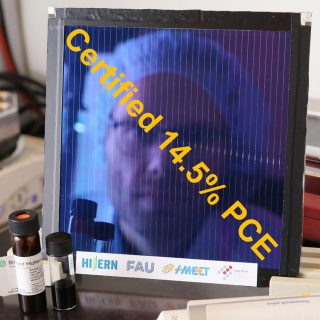Achieving Record Efficiency in Upscaled Organic Photovoltaic Modules
Recent advancements in organic photovoltaics (OPVs) have propelled small-cell power conversion efficiencies (PCEs) close to 20%. However, transitioning these efficiencies from small cells to large-area modules remains challenging due to lower PCEs at the module level. This study focuses on the upscaling of PM6:Y6-C12:PC61BM-based devices, transitioning from small-area cells to large-area modules with minimal performance degradation. A novel blade coating process supported by computational fluid dynamics simulations enables uniform coatings with less than 5% thickness variation across 200 cm². Furthermore, module layout optimizations through finite element method simulations reduce losses due to electrode resistances and inactive interconnect areas to 1.9% and 3.5%, respectively. The culmination of this research is a 204-cm² OPV module, setting a new world record with a certified PCE of 14.5% (15.0% on the active area). This breakthrough demonstrates the potential of OPVs to approach the performance of conventional photovoltaic technologies, emphasizing the importance of upscaling research to bridge the efficiency gap between small cells and large modules.
More details on producing the record modules are published in Joule 8, 1–9, April 17, 2024

